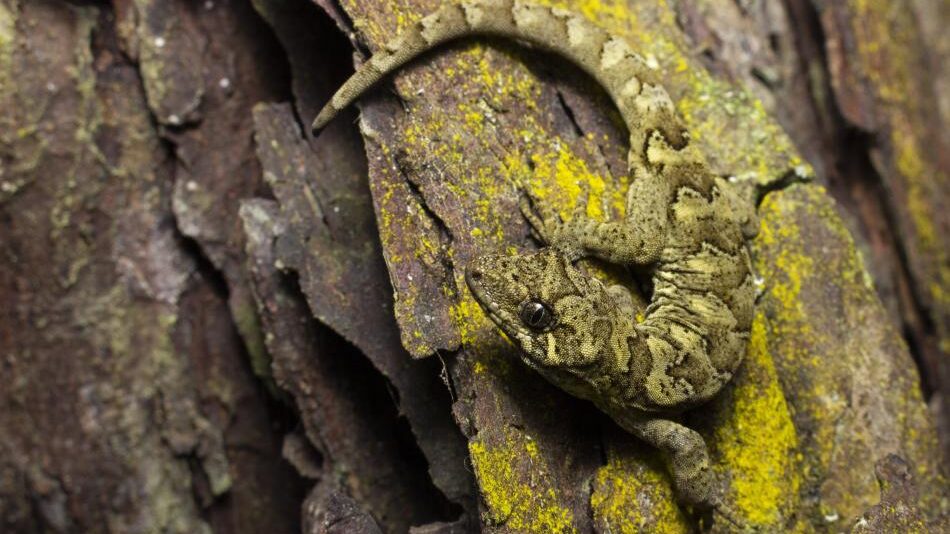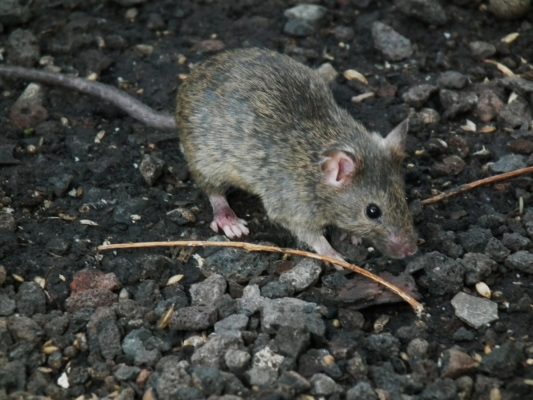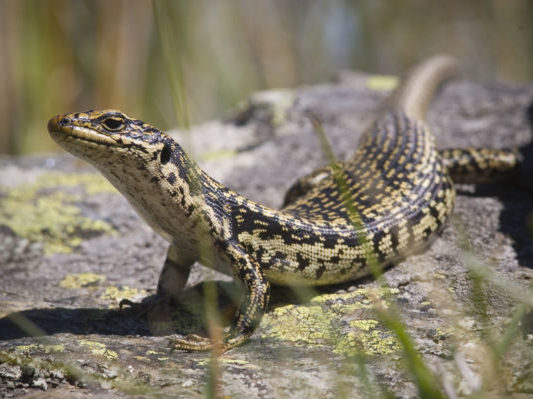The detrimental effects of New Zealand’s larger mammal predators are very well documented. Everyone surely knows the devastation caused by rats, possums and stoats. So what about mice? At this time of year they can be a nuisance in your pantry and a worry to your wiring – but what are the impacts of mice on our smaller wildlife such as skinks and geckos? And what other threats do our endemic reptiles face?

While most of our native birds can probably hold their own against a mouse, our skinks and geckos are more vulnerable. Grant Norbury (Landcare Research, Alexandra) and others looked at the impacts of house mice on the survival of translocated lizards released in a 0.3-ha area of grassland/shrubland which had been cleared of invasive mammals.
Otago skinks, along with grand skinks are some of New Zealand’s largest and most impressive lizards and are found only in the Otago region. Twelve captive-reared Otago skinks were originally released in the area which was surrounded by a mammal-resistant fence. Two years later, another 16 skinks were released. Mice subsequently invaded the lizard sanctuary for a period of approximately 160 days, with peak mouse density reaching at least 63 mice/ha.

Mice were seen attacking skinks larger than 25cm – the first time this had been observed – so they were definitely a threat to the skinks. But what was their measured impact? Norbury et al estimated skink survival and detectability in both the presence and absence of mice and found that “survival of skinks from the first cohort during the mouse incursion was unaffected, presumably because they were already established and had access to familiar or more optimal refugia. Their survival over the entire three years of monitoring compared favourably with published estimates for viable populations in the wild, protected from all invasive mammals.”
While the results suggest that captive-reared skinks can be successfully released into the wild, the scientists warn that mice are potentially a limiting factor to successful establishment. This is particularly a concern during the initial translocation phase, when the lizards are in an unfamiliar environment and have yet to locate optimal refuges, meaning that they are more vulnerable in encounters with mice.
The full research article is freely available from the New Zealand Journal of Ecology.
Impacts of invasive house mice on post-release survival of translocated lizards (2014)
One of the issues with ensuring the survival of New Zealand’s unique skink and gecko species is that there may still be species and subspecies that are as yet undiscovered. Between 1980 and 1994, the list of known extant New Zealand herpetofauna increased by about 64%.
According to a report by Charles H. Daugherty, G. B. Patterson and R. A. Hitchmough, (published in the New Zealand Journal of Zoology 1994, online 2010), New Zealand has at least 65 endemic species of terrestrial reptiles and amphibians. Of those at least 30 species (46%) are rare, threatened, or endangered, and 26 species (40%) are restricted largely or entirely to offshore islands.
The review is freely available online. Taxonomic and conservation review of the New Zealand herpetofauna (1994, 2010)
Some years have passed since that herpetofauna review was first published and, just this year, the Journal of the Royal Society of New Zealand has devoted a special issue to New Zealand herpetology. This 2016 Special Issue includes an article on the current challenges and future issues of lizard conservation written by Department of Conservation researchers, R.A. Hitchmough, L.K. Adams, J.T. Reardon and J.M. Monks.

In 2016, taxonomic uncertainty remains as to the actual number and identity of lizard species we have – but the total has grown considerably since 1994, from ‘at least 65’ to 99 and counting! The authors state that “New Zealand has one of the most diverse lizard faunas in the world for a temperate landmass on a species per area basis, with 99 endemic described and proposed new species known and further discoveries likely.”
Among the threats to our lizard species the authors list the usual suspects – invasive mammal predators and ongoing habitat destruction. The good news is that: “Previously sparse island populations of species have recovered strongly following eradication of pest mammals and translocations of lizards to newly mammal-free islands have boosted security for some species. Recent success with intensive predator control and predator-proof fencing on the mainland shows promise for lizard populations in easily accessible sites.”
Success stories include Grand and Otago skinks at Macraes Flat which have gone from being ‘Nationally Critical’ to an improved status of ‘Nationally Endangered’ following intensive predator control. Also illustrating the effects of good predator control, small skinks on farmland in the Hawkes Bay have gone from previously undetectable levels to now being abundant in the area, following landscape scale predator control. In adjacent farmland, without predator control, population levels remain undetectable.
While several species are now showing a strong recovery after being “acutely threatened”, the outlook for others looks bleak: “The only known mainland population of Oligosoma whitakeri at Pukerua Bay, has continued to decline towards extinction despite habitat protection, removal of livestock and an attempt at predator control. Captive management of this population is underway and at present appears to provide the only hope for its persistence.”
Introduced mammals and habitat loss are the major drivers of lizard declines on mainland New Zealand, but the authors also identified poaching, the impacts of invasive introduced reptiles, disease and climate change as emerging or potential threats. Their grim warning for the future of our endemic reptiles is that: “Further advances in predator control techniques and increased funding for lizard conservation management are needed to prevent species extinctions.”
The full review is freely available.
Current challenges and future directions in lizard conservation in New Zealand (2016)

